Recent Articles
Popular Makes
Body Types
2020 Ford F-250 Road Test and Review
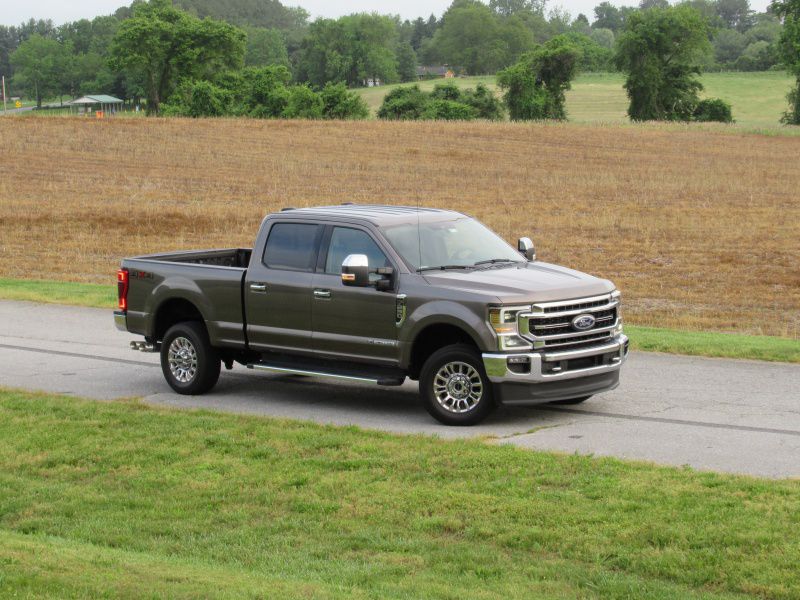
2020 Ford F-250 Lariat crew cab ・ Photo by Brady Holt
With today’s full-size pickup trucks, the term “light-duty” should be stricken from our vocabularies. The Ford F-150, the “light-duty” member for the Ford F-Series lineup, boasts tow ratings of up to 13,200 pounds and payload capacities of up to 3,270 pounds. That’s just about what you could get from the Ford F-250 Super Duty when the company debuted the “Super Duty” name in 1999.
Still, when you need to handle an even mightier load, or when you’d rather risk overkill than risk overworking a smaller truck, the current Super Duty lineup is stronger than ever. The 2020 Ford F-250 Super Duty is freshly updated with upgraded powertrains, new technology, and, of course, mightier specs than ever. It’s the entry level to the Super Duty lineup, known as a three-quarter-ton pickup, and that’s already more than enough to trounce the F-150 — and, in many ways, the competition. Prices start at $33,705 for a base-model work truck and surpass $90,000 with all the options. Let’s go over what you get for that money to see whether this mighty truck is for you.
This Year's Updates
The current-generation Ford F-250 arrived as a 2017 model, but this year brought a host of upgrades in response to freshly redesigned competitors from Ram and Chevrolet. While the truck doesn’t look very different, it’s gotten stronger, more advanced, and more efficient.
Cosmetically, the biggest difference is that Ford removed big chrome bars from the grille, which the company said improves the engine’s cooling. Under the hood, there’s a newly available 7.3-liter gasoline V8 engine, and an upgrade to the familiar 6.7-liter Power Stroke diesel that boosts torque past 1,000 lb-ft. Both engines, along with a carryover 6.2-liter V8, now use a 10-speed automatic transmission. Towing capacities have improved, and a new towing feature lets you back up a trailer using a dashboard knob. Newly available safety features include adaptive cruise control, emergency automatic braking, and lane-keeping steering assistance. The cabin now offers USB-C ports in addition to the older-stye ports, along with a wireless smartphone charger. And a new Tremor model adds off-road capability.
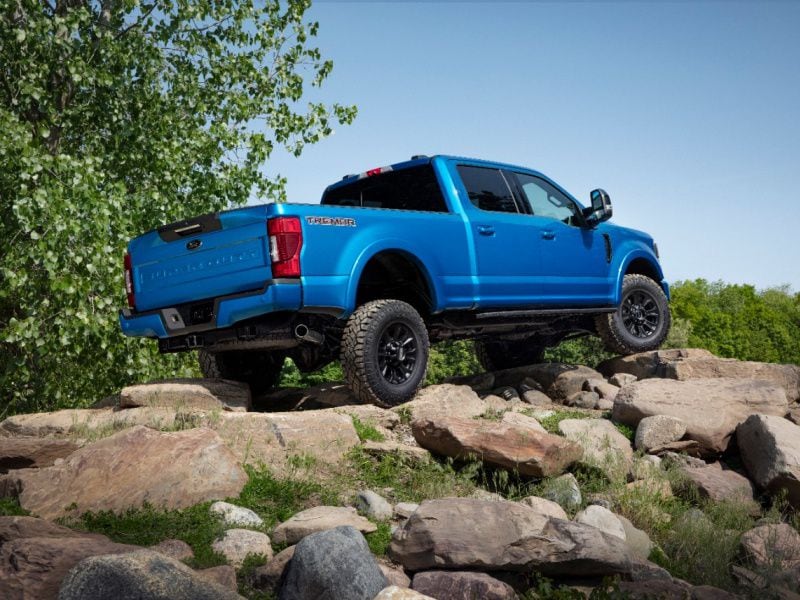
Photo by Ford
Function-Focused Design
The F-250 is designed for utility, not beauty. Ford says so directly, and the 2020 styling updates explicitly target “function over form.” It’s a large boxy pickup with some chrome decoration and big mirrors sticking off the side. A low plastic air dam hangs below the front bumper to improve aerodynamics. The F-250 isn’t a truck that tries to be especially elegant, nor one with over-the-top tough cues. It doesn’t have to show off to command respect. Some buyers will appreciate this focus, while others might demand more “form” to accompany their “function” at these prices.
The F-250’s interior is pleasant, functional, and welcoming. It’s laden with luxury and convenience features, and generally well-finished. Nothing about this interior says “I’m a mere work truck.” But it also doesn’t dazzle you like the latest RAM 2500, whose Mercedes-grade materials and jumbo-size touchscreen would look at home in any $70,000-plus vehicle. By contrast, the F-250’s cabin is simple and user-friendly, but it’s not going to win design awards. Here, too, opinions will differ on which approach makes a better luxury truck: more luxury, or more truck. One F-250 miscue: The parking brake bursts upward with alarming force when you pull its release handle.
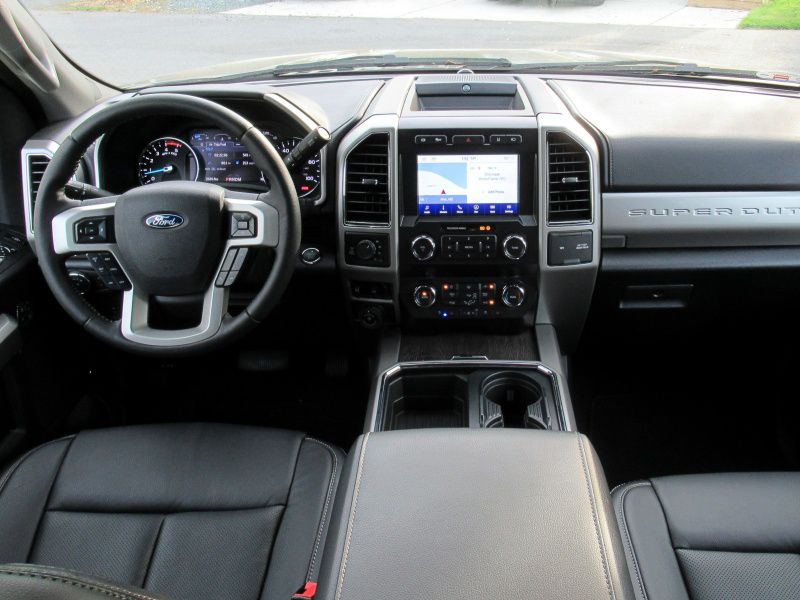
Photo by Brady Holt
Massive Interior
The 2020 Ford F-250 is available as a regular cab with no rear seat, as an extended cab (“SuperCab” in Ford-speak) with a small rear seat and rear-hinged rear doors, and a crew cab with a massively spacious interior and four swing-out doors. Our crew cab test vehicle had ample space in the front and rear, with almost ridiculous rear legroom. We wish there were a middle ground between the SuperCab’s merely adequate rear seating and the crew cab’s surplus of space.
When you’re hauling cargo instead of passengers, the rear seat flips up easily in two sections to create a secure, dry cargo hold. In the crew cab, doing this leaves more space than behind the back seats of many small suvs. Note that competing three-quarter-ton pickups have conventional rear doors on their extended-cab models, which makes it easier for rear passengers to get in and out quickly. However, the Ford’s approach means there’s no central roof pillar where the doors meet, so it’s easier to load bulky cargo into the rear of the cabin. Choose accordingly.
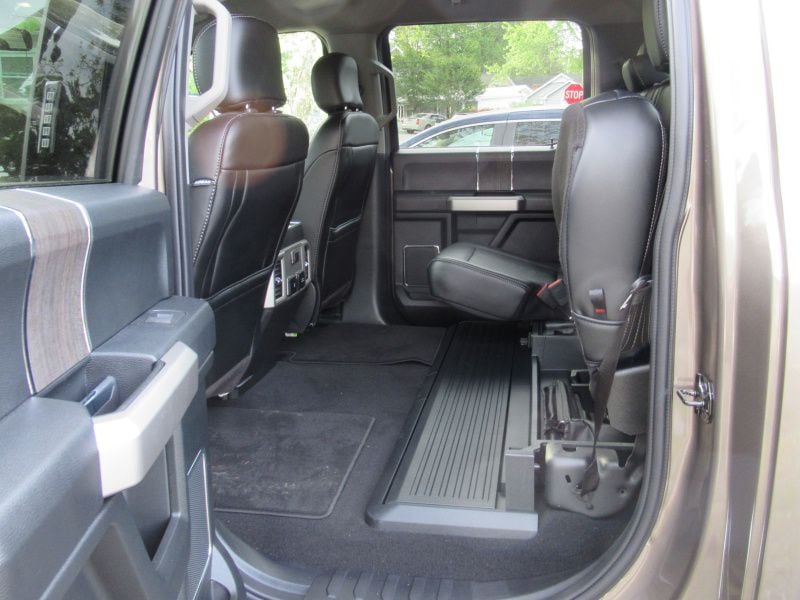
Photo by Brady Holt
Massive Capability
Today’s heavy-duty pickups are so capable that the spec sheets can be little more than bragging rights. Still, the F-250 has a lot to brag about. Its payload capacity reaches 4,260 pounds on a rear-wheel-drive regular-cab model, while our tested four-wheel-drive crew cab is rated for 3,320 pounds. For comparison, the Chevrolet Silverado 2500HD offers similar crew cab payload but its rear-drive regular cab tops out at 3,991 pounds. The RAM 2500 has a massive payload capacity of up to 4,380 pounds on the regular cab and 3,530 pounds on the four-wheel-drive crew cab.
For towing, the F-250 reaches 20,000 pounds with its upgraded diesel engine, including on our tested four-wheel-drive crew cab. The Silverado tops out at 18,500 pounds (including on the 4x4 crew cab), and while the Ram reaches as high as 19,680 pounds in certain configurations, the four-wheel-drive crew cab stops at 17,890 pounds. Beyond the numbers, the F-250 also offers a class-exclusive system it calls “Pro Trailer Backup Assist,” which provides automatic steering after you input the trailer’s dimensions and twist a dashboard knob in the desired direction.
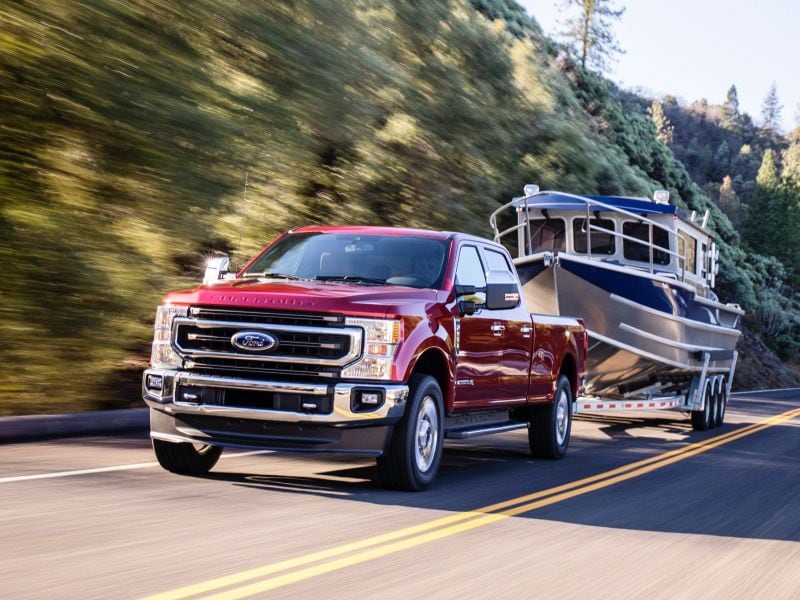
Photo by Ford
Drives Like a Truck
It has become popular to describe today’s pickups as driving like luxury cars. While they’ve certainly become civilized compared to old work trucks, the 2020 Ford F-250 remains a truck. This is a huge, heavy vehicle that demands your respect and attention. This is a truck that won’t swerve nimbly around an obstacle, or stop on a dime. If you’re going too fast and or following other traffic too closely, you’re putting people’s lives at risk. The ride is bumpy by car standards, and let that serve as a reminder that you’re not driving a car.
The base engine is a 6.2-liter V8 with 385 horsepower and 430 lb-ft of torque, while this year adds an available 7.3-liter V8 with 430 hp and 475 lb-ft. That improves acceleration and towing capabilities without the expense of a diesel, and it’s a class leader. The 6.7-liter Power Stroke V8, though, is the mighty heart of the F-250. It cost an extra $10,495 on our test truck, but it provides 475 hp and 1,050 lb-ft of torque — both class-leading figures as well. The EPA doesn’t rate three-quarter-ton trucks’ fuel economy, but our test truck averaged an impressive 21 mpg in a mix of rural, highway, and suburban driving.
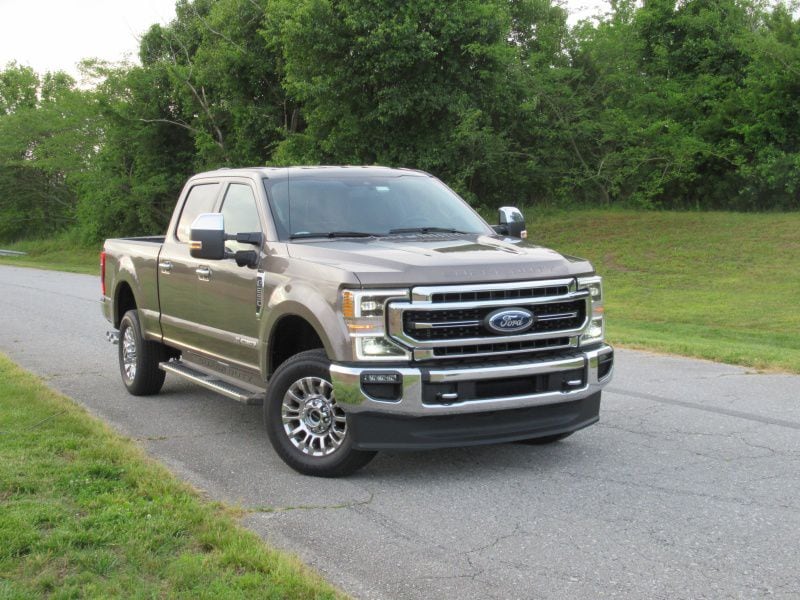
Photo by Brady Holt
Modern Amenities
Given the F-250’s mighty capabilities, it’s understandable it doesn’t drive like a luxury sports sedan. But the features list is about as complete as any other high-end vehicle’s, thanks to some new 2020 additions.
You can get the F-250 with rich leather upholstery, heated and ventilated front seats, a heated steering wheel, woodgrain interior trim, premium sound systems, a fully featured 8-inch infotainment system on nearly all trim levels, and a built-in Wi-Fi hotspot. And nearly all trim levels now include safety technology that was either unavailable or hard to find last year: adaptive cruise control, a forward collision warning with automatic emergency braking, a lane-departure warning with lane-keeping steering assistance, and blind-spot monitoring with a rear cross-traffic alert. A surround-view parking camera, which provides a bird’s-eye view of the F-250 and its surroundings, is another welcome add-on for close-quarters maneuvering.
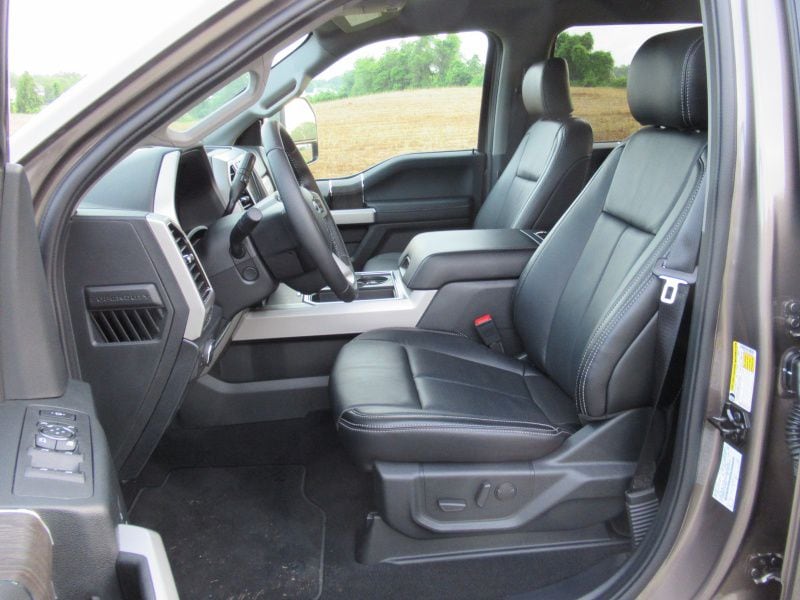
Photo by Brady Holt
Range of Prices
As we mentioned, the 2020 Ford F-250 is available in a wide range of prices, from $33,705 to more than $90,000. That’s because you can choose everything from a stripped-down work truck with no back seat to an opulently finished, yet wildly capable, spacious cruiser.
In the interest of space, we’ll focus on the family-friendly crew cab that’s the most popular among private owners. It starts at $37,295 in base XL form, with vinyl seats, no carpeting, and mostly black plastic exterior trim. Retail buyers will almost certainly move up to the cloth-upholstered XLT ($42,980) or the leather-trimmed Lariat ($48,390). And for the maximum glitz, Ford sells the King Ranch ($59,000), Platinum ($65,895), and Limited ($83,600). Prices can rise fast, too; our Lariat test vehicle ballooned to $72,955. Four-wheel-drive added more than $3,000, while the diesel engine added more than $10,000 more. Other pricey extras included $1,130 for higher-capacity towing equipment, $1,180 for upgraded LED headlights, $1,000 for adaptive steering that lightens the effort at low speeds, and $595 for a spray-in bedliner.
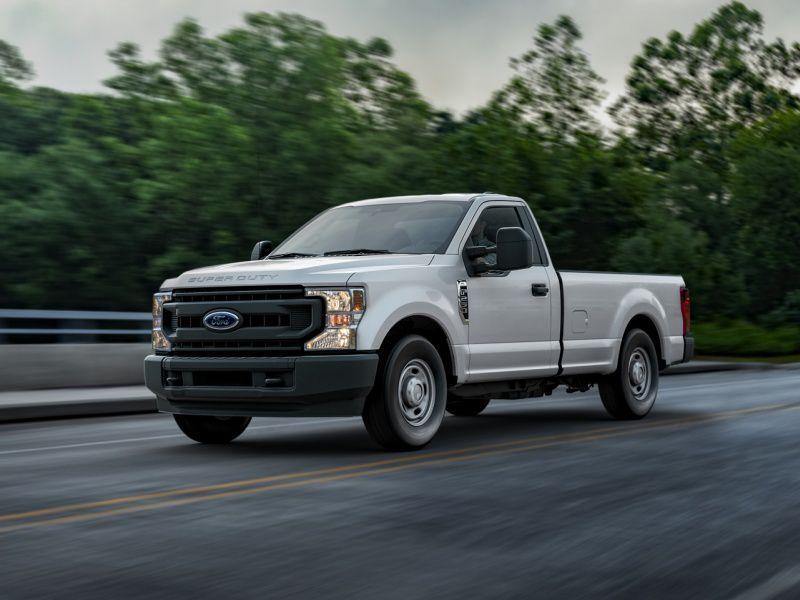
Photo by Ford
Competitors and Alternatives
In the three-quarter-ton pickup segment, the Ram 2500 has been catching a lot of attention for its extra-smooth ride and extra-posh interior. Even Ford loyalists would do well to check it out if those are priorities. Meanwhile, General Motors has just introduced new camera views on its redesigned Chevrolet Silverado 2500HD and GMC Sierra 2500HD that will help anyone towing a bulky trailer, including one that renders the road around you with the trailer “invisible.” But the F-250’s businesslike aesthetic and unimpeachable capability remain strong arguments.
You might also consider other F-Series models. The F-150 is less expensive and more maneuverable than the F-250, and it’s still available with ample space and tremendous capabilities. You can even get it with a diesel engine now, though it’s a V6 instead of the F-250’s V8. Don’t let the name fool you, though: The F-150 shares little cosmetically or mechanically with the Super Duty line. Among other Super Duty vehicles, Ford also offers the F-350 and F-450. They offer a stiffer suspension with higher payload capabilities than the F-250 at the expense of a bumpier ride. And they’re the only way to get a “dualie” configuration with four rear wheels, expanding their abilities (and their tough look) even further. But, of course, they’re more expensive.
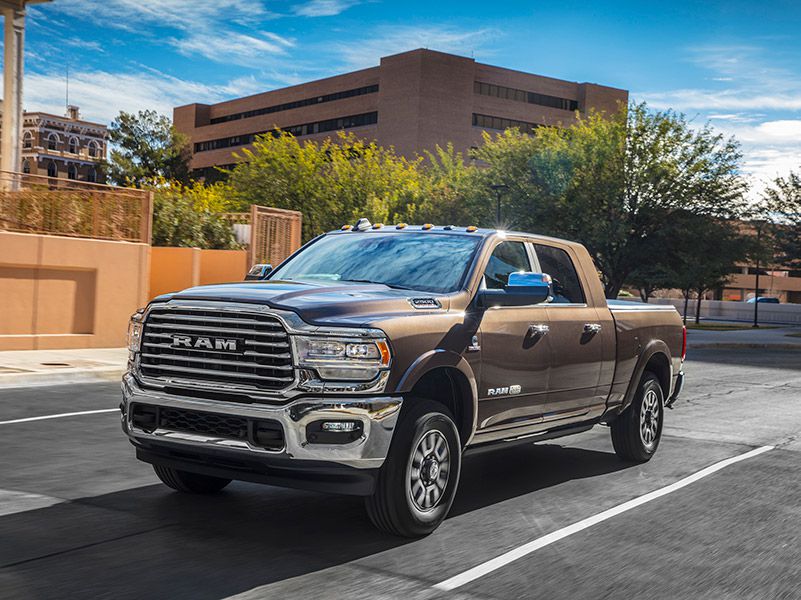
Photo by Fiat Chrysler Automobiles
Final Thoughts
The 2020 Ford F-250 takes a ridiculously capable truck and wraps it in creature comforts. It generally out-works its competitors without overly penalizing an owner who uses it as a commuter car.
At $73,000 as tested, some buyers might demand more pizzazz and panache. For others, the spec sheet victories are already enough reason to pick the F-250 over the competition, and its decent driving manners and respectable cabin are icing on the cake.
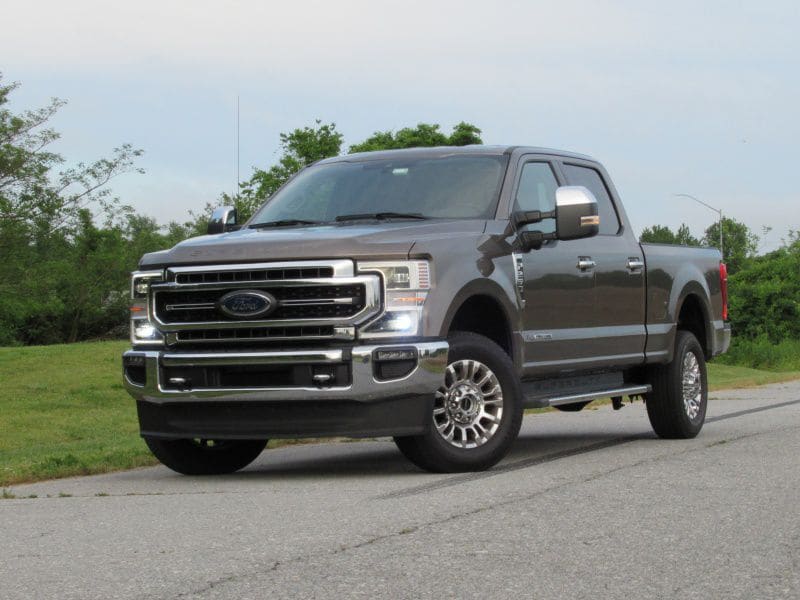
Photo by Brady Holt